Whenever something goes wrong on the farm, we often find ourselves reciting the words, “If Only,” as we look back on the situation. “If only I let that fresh cow in the box pen one more night.” “If only I made sure that calf had colostrum within the first four hours.” “If only I reminded the morning milker to make sure she is stripping quarters and checking for mastitis.”
A protocol is something defined as a procedure that must be followed to ensure things are done properly and thoroughly each time they are done. On many small dairy farms and even some larger ones, we carry our protocols in our heads. We know inherently what to do in a specific situation to make sure the animal receives the care she needs. Unfortunately, though, having them written down and posted somewhere everyone can access them is where we fall short.
The National FARM (Farmers Assuring Responsible Management) Program requires that all participating farms have written protocols for important aspects of dairy herd management – calf care, vaccination and preventative treatment protocols, transition cows, mastitis, down cows, lameness, and other issues. The Center for Dairy Excellence even offers a record-keeping book where you can write all those protocols down to comply with the National FARM Program.

But having them documented on the computer or writing them down in a record-keeping book that is gathering dust on the office desk doesn’t help when you’re swamped with a million things coming your way, running on empty, and making decisions as quickly as you can to just get things done. That’s when things go wrong. That’s when that fresh cow gets let out too soon and ends up down in the freestall alley, or when that baby calf won’t get up because she has scours and is severely dehydrated.
That’s why having written protocols posted in plain sight and shared with everyone who works with the cows is so important. Even on smaller farms, we can’t ensure that the person who knows the specific protocol is always going to be there to make sure it is administered properly. What if a fresh cow calves while you’re at a meeting somewhere? Does the person who is actually working on the farm that day know the importance of getting colostrum to that calf within the first four hours?
This is the time of year when many people make New Year’s resolutions. A resolution that could be very helpful the next time something goes wrong is having written protocols posted on your farm. Writing protocols doesn’t have to be hard. You can follow these basic guidelines in writing and posting them.
- Keep them simple. Take the time to physically walk through the steps you follow to do a specific task on the farm, like caring for a newborn calf, and then write it down step by step. To test the protocol, ask someone to follow the steps on the paper and see what they missed. It should be written simple enough that anyone could take that protocol and follow the steps to complete the task.
- Share them with your family and employees. Sometimes on a farm, we are so busy focusing on getting things done that we miss how important communication is to ensuring those things are done correctly. Scheduling a meeting or taking a half hour to sit down with your employees and family members to review your protocols and explain why they’re so important can go a long way to ensuring they get done consistently every time.
- Post them somewhere everyone can see them. The National FARM Program has helped producers come a long way in documenting their protocols. But those protocols need to be posted where everyone can see them. Mount a bulletin board in front of the parlor and post them there, or hang them in the milkhouse where you turn the milk pump on. Wherever you post them, they should be easy to see and easy to find in case of an emergency.
If you would like help in drafting your protocols, you can request one of the Center’s Animal Care Record-Keeping Books at no charge. The book outlines the areas of management that need written protocols. It also includes a section for documenting medicine use in your herd. Call the Center at 717-346-0849, email me at jsebright@centerfordairyexcellence.org or go to www.centerfordairyexcellence.org/request-book.
The Center and partnering organizations will also be hosting Animal Care Workshops on dairy farms this spring to help dairy producers and your employees get the training required by the National FARM Program on calf care, dry cow management, and other key management areas. There are five regional workshops planned across the state. To learn more and register for one near your farm, call the Center or visit www.centerfordairyexcellence.org/animal-care.
It is easy to make sure protocols are being followed when you’re not that busy and you have the time you need to slow down and remember what you did last time and what works best. But we all know that time is a luxury we don’t always have on the farm. Often it’s in the middle of an emergency that you need to remember what worked best last time. Making a resolution this year to have written protocols posted on your farm will help you from finding yourself saying the words, “If Only.”
Editor’s Note: This column is written by Jayne Sebright, executive director for the Center for Dairy Excellence.

